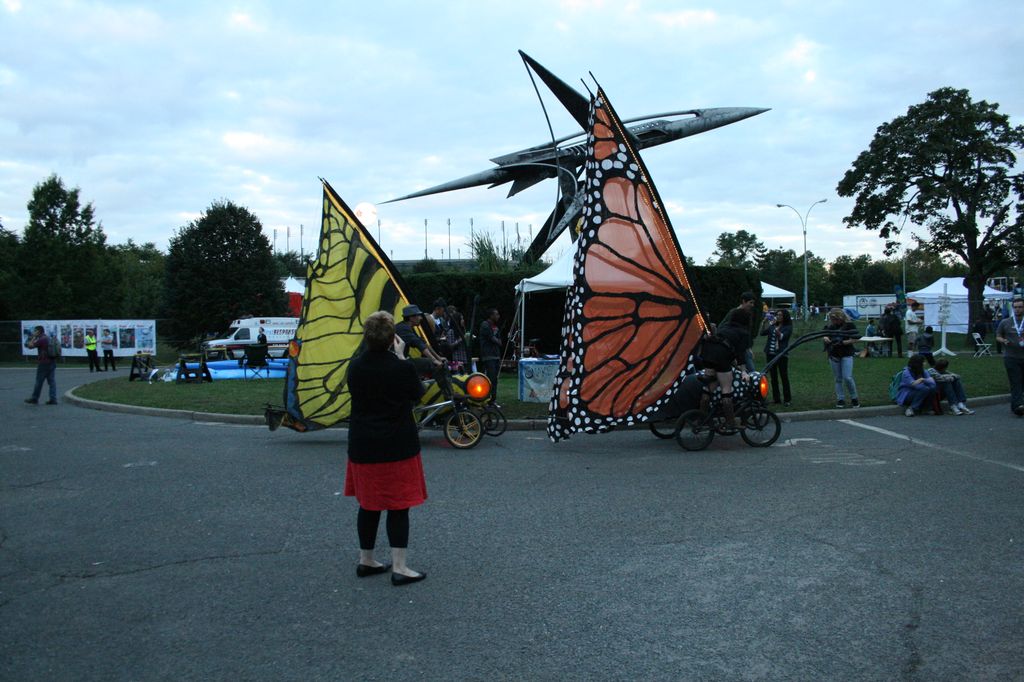A Day at Maker Faire // As Seen by Joanna Beltowska
 Oct 4, 2012 Tweet
Oct 4, 2012 Tweet Created by Make Magazine in 2006, Maker Faire 2012 is actually the 15th installation of the event which celebrates science, engineering, arts and crafts, and do-it-yourself enthusiasm.
 The Maker Movement encompasses a wide variety of disciplines and interests
The Maker Movement encompasses a wide variety of disciplines and interests
 my favorite part of Maker Faire
my favorite part of Maker Faire
As we make our way into the event area, it strikes me that this could be the world’s biggest gathering of creative minds – aside from the Internet, of course – and they are surprisingly diverse. There are seemingly as many men as women in attendance, many with excited children in tow. The crowd is wonderfully eclectic: I see Park Slope parents mixed with geeky hobby tinkerers, steampunks, robot lovers (many times accompanied by robots that they’ve built themselves), japanese cyber-punks, and the odd eccentric (Metrocard Man , I am looking at you).
 The Social Gumball Machine dispenses candy via texts and Twitter messages
The Social Gumball Machine dispenses candy via texts and Twitter messages
Our first course of action is to find some food (a long car drives makes wonders for the appetite). While waiting in line to the Asia Dog stand, we have our first encounter with a maker project. The Social Gumball Machine is activated via Twitter messages and texts. A young boy struggles to figure out how to open it, almost desperately tugging at its lid. A friendly Maker Faire visitor explains the mechanism to him, urging him to ask his parents for assistance. A short moment later, the boy gets his candy, and in doing so reveals the wonder of the machine to the latest newcomers in line, who quickly pull up their phones to score their share of free candy. Maker projects certainly make for great conversation starters and catalysts for interaction.
 Interviewing a wheeled cupcake
Interviewing a wheeled cupcake
Fed and satisfied, we walk over to the Auditorium, passing super-sized wheeled cupcakes and bicycles disguised as giant bees and butterflies. Two famous thinkers are about to speak about the Maker Movement; Seth Godin, and Chris Anderson, both authors and entrepreneurs, the latter also editor-in-chief of Wired Magazine and co-founder of robotic manufacturing company 3D Robotics. Anderson is accompanied by Bre Pettis , co-founder and CEO of MakerBot Industries; the two are giving a talk on how the Maker Movement, and 3-D printing in particular, might spark a new age of manufacturing in the US.
But first, Godin.
We arrive a bit early, catching the tail-end of Massimo Banzi and Alf-Egil Bogentalk’s Arduino hour. The Auditorium is filling up with a white noise of muffled, disruptive sounds produced by visitors shuffling about, trying to find space for the upcoming big-name attractions. We get lucky and find seats in the center. Godin’s talk addresses the transformational effect that industrialism has had on our culture. While its contributions cannot be understated, industrialism has also helped shape a society obsessed with optimization, constantly striving to make things faster, stronger, smoother, better. Such a society designs for compliance; it processes the risk-taking makers poorly.

This risk-taking stems from the very nature of hacking and science, which are about doing things over and over again and failing until you succeed. Our industrial heritage has brainwashed us to do things right; we balk at uncertainty. But without a willingness to fail, one cannot innovate. Godin concludes that what we need isn’t a new wave of industrialization but rather ways of becoming more human. The Internet, being a platform for making connections and making things that matter, is the most powerful tool to help us do so.
 Chris Anderson and Bre Pettis’s Q&A.
Chris Anderson and Bre Pettis’s Q&A.
Chris Anderson’s talk mirrors the narrative of his new book on the Maker Movement, suitably titled “Makers” . Anderson too explores the impact that manufacturing revolutions have had on our lives. He hypothesizes that we’re currently experiencing the infancy of a third industrial revolution, sparked by the advent of affordable advanced desktop 3-D printers.
This new revolution has been made possible via the democratization of creation (thanks to the 2-D printer) and distribution (thanks to the Internet), which we’re now beginning to see applied to manufacturing. 3-D printers provide alternatives that lower the barrier for innovators to become entrepreneurs, enabling them to opt out of the traditional innovation model that is structured around economies of scale. The implication is that the biggest shift doesn’t like in how things are being made, but in who is making them.
 Bre Pettis, Makerbot Co-Founder and CEO of MakerBot Industries
Bre Pettis, Makerbot Co-Founder and CEO of MakerBot Industries
(The 3-D printers and MakerBot in particular are, by the way, clearly the cool kids of Maker Faire. The 3-D printing section is perpetually jam-packed and applications of this new exciting technology are sprinkled throughout the many maker stations; Bre Pettis speculates that 30% of Maker Faire is MakerBot.)
While we leave the Auditorium and stroll towards the Arduino station, I ponder over my Maker Faire experience. Anderson’s prediction that the Maker Movement could be the Next Big Thing, boosting American manufacturing, surely is a very compelling vision for the future. But the reality of course is that people have always been making things. The radical difference today, and what has swung the gates wide open for things like the Maker Movement and Maker Faire, is that it’s never been easier to find good and useful resources for free or very cheap. More importantly, it’s never been so easy to find and connect with others who share your interests, however nerdy and niche they may be.
 Butterflies on Bikes
Butterflies on Bikes
 Every Child is a Maker
Every Child is a Maker
Follow Joanna // @jbeltowska

